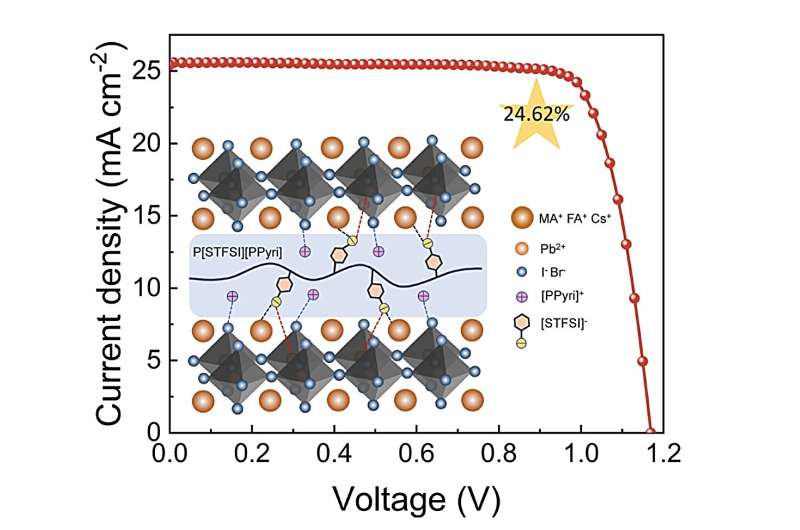
Perovskite solar cells, which use materials with the same crystal structure as perovskite, are lightweight, flexible, easy to manufacture, and inexpensive. They can be attached to many different surfaces and are a promising technology. However, current perovskite solar cells are not durable, and they tend to be inefficient.
Research shows how additive engineering with a polymerized ionic liquid to the metal halide perovskite material can improve the solar cell's function, helping to pave the way for the future wide adoption of perovskite solar cells.
The research was published in Energy Materials and Devices on March 29.
"The commonly employed solution processing method for fabricating perovskite layers introduces many defects in both the bulk and surface of the perovskite layer. These intrinsic defects within the perovskite absorption layer pose a significant constraint on the overall performance of the devices.
"Additive engineering has been demonstrated to be effective as a strategy for defect passivation and performance enhancement in perovskite solar cells," said Qi Cao, a researcher at Northwestern Polytechnical University in Xi'an, China.
To further improve the ionic liquids added to perovskite solar cells, researchers can create polymerized or poly ionic liquids. Polymers are added to ionic liquids, enhancing the properties of the ionic liquid. In this study, researchers synthesized a poly ionic liquid called poly4-styrenesulfonyl(trifluoremethylsulfonyl)imidepyridine, or PSTSIPPyri for short.
The addition of PSTSIPPyri to the metal halide perovskite solar cell has many benefits. It can prevent halide ion migration, which helps maintain the crystal structure, and facilitate the fixation of organic and halide ions, which improves the solar cell's stability.
"To date, researchers have devoted considerable attention to the meticulous selection of additives that enhance the performance of perovskite solar cells. Among these, ionic liquids have received widespread attention. Ionic bonds in ionic liquids tend to be stronger and more stable, and they offer various tunable properties, including viscosity, polarity, and conductivity," said Xuanhua Li, a researcher at Northwestern Polytechnical University.
"This tunability makes it possible to fine-tune the ionic liquid properties to meet the specific requirements of the perovskite film, thereby optimizing device performance."
To test the success of the addition of PSTSIPPyri, researchers conducted comprehensive studies of the perovskite solar cells with the poly ionic liquid, especially for factors that are essential for the performance of the solar cells. The perovskite films were aged for 300 hours at 85°C and 60% relative humidity. The enhanced perovskite film had a slower rate of change than the perovskite film with the poly ionic liquid.
In a high humidity, high heat environment, it also maintained 84.5% of its efficiency after 1000 hours, while the control perovskite solar cell only maintained 43.6% of its initial efficiency.
Since perovskite solar cells are often less durable than alternatives, it was important to test the long-term durability of the perovskite solar cell with the addition of PSTSIPPyri. With the poly ionic liquid, the perovskite solar cell maintained 87.6% of its power conversion efficiency after 1,500 hours of continuous light, compared to the control which only maintained 61.1% of its power conversion efficiency.
"Incorporating PSTSIPPyri as an additive leads to a significant enhancement in the power conversion efficiency of inverted perovskite solar cells from 22.06% to 24.62%. They also demonstrate excellent long-term operational stability," said Cao. "This strategy illustrates the potential of poly ionic liquids as a promising additive for perovskite solar cells, offering both high performance and stability."
Other contributors include Xingyuan Chen, Tong Wang, Jiabao Yang, Xingyu Pu, Hui Chen, Bingxiu Xue, and Jianbo Yin at Northwestern Polytechnical University in Xi'an, China; Long Jiang at the CNPC Tubular Goods Research Institute in Xi'an, China.
More information: Xingyuan Chen et al, Efficiency enhancement to 24.62% in inverted perovskite solar cells through poly (ionic liquid) bulk modification, Energy Materials and Devices (2024). DOI: 10.26599/EMD.2024.9370029
Provided by Tsinghua University Press
Citation: Research shows adding polymerized ionic liquid improves performance of perovskite solar cells (2024, May 15) retrieved 15 May 2024 from https://techxplore.com/news/2024-05-adding-polymerized-ionic-liquid-perovskite.html
This document is subject to copyright. Apart from any fair dealing for the purpose of private study or research, no part may be reproduced without the written permission. The content is provided for information purposes only.
